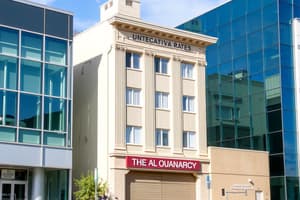Podcast
Questions and Answers
Which depreciation method results in a decreasing charge over the useful life?
Which depreciation method results in a decreasing charge over the useful life?
- Sum-of-the-years'-digits method
- Straight-line method
- Units of production method
- Double-declining balance method (correct)
Why is a depreciation method based on revenue generated by an activity not appropriate?
Why is a depreciation method based on revenue generated by an activity not appropriate?
- It ensures even allocation of cost
- It is consistent with IAS 36 guidelines
- It reflects factors unrelated to asset consumption (correct)
- It simplifies useful life determination
What does an entity consider when selecting a depreciation method?
What does an entity consider when selecting a depreciation method?
- Historical cost of the asset
- Current market trends
- Expected pattern of consumption of future economic benefits (correct)
- Tax implications
Why is it important to apply the selected depreciation method consistently over periods?
Why is it important to apply the selected depreciation method consistently over periods?
Which factor may affect the price component of revenue but not the way an asset is consumed?
Which factor may affect the price component of revenue but not the way an asset is consumed?
How does an entity determine if an item of property, plant, and equipment is impaired?
How does an entity determine if an item of property, plant, and equipment is impaired?
What may be necessary to depreciate the remainder in a manner that represents the consumption pattern and useful life of its parts?
What may be necessary to depreciate the remainder in a manner that represents the consumption pattern and useful life of its parts?
When can an entity choose to depreciate separately the parts of an item?
When can an entity choose to depreciate separately the parts of an item?
Where should the depreciation charge for each period be recognized?
Where should the depreciation charge for each period be recognized?
In what situation is the depreciation charge included in the carrying amount of another asset?
In what situation is the depreciation charge included in the carrying amount of another asset?
How is the depreciation of manufacturing plant and equipment accounted for in the costs of conversion of inventories?
How is the depreciation of manufacturing plant and equipment accounted for in the costs of conversion of inventories?
In what circumstance may depreciation of property, plant, and equipment used for development activities be included in the cost of an intangible asset?
In what circumstance may depreciation of property, plant, and equipment used for development activities be included in the cost of an intangible asset?
When should an entity recognise the cost of replacing part of an item of property, plant and equipment?
When should an entity recognise the cost of replacing part of an item of property, plant and equipment?
What happens to the carrying amount of parts that are replaced in an item of property, plant, and equipment?
What happens to the carrying amount of parts that are replaced in an item of property, plant, and equipment?
When should the cost of performing regular major inspections for faults be recognised in the carrying amount of an item of property, plant, and equipment?
When should the cost of performing regular major inspections for faults be recognised in the carrying amount of an item of property, plant, and equipment?
What is derecognised in an item of property, plant, and equipment after a major inspection is performed?
What is derecognised in an item of property, plant, and equipment after a major inspection is performed?
How does an entity determine the cost of a future similar inspection for an item of property, plant, and equipment?
How does an entity determine the cost of a future similar inspection for an item of property, plant, and equipment?
What does the recognition principle in paragraph 7 dictate when it comes to allocating costs to property, plant, and equipment?
What does the recognition principle in paragraph 7 dictate when it comes to allocating costs to property, plant, and equipment?
Flashcards are hidden until you start studying




